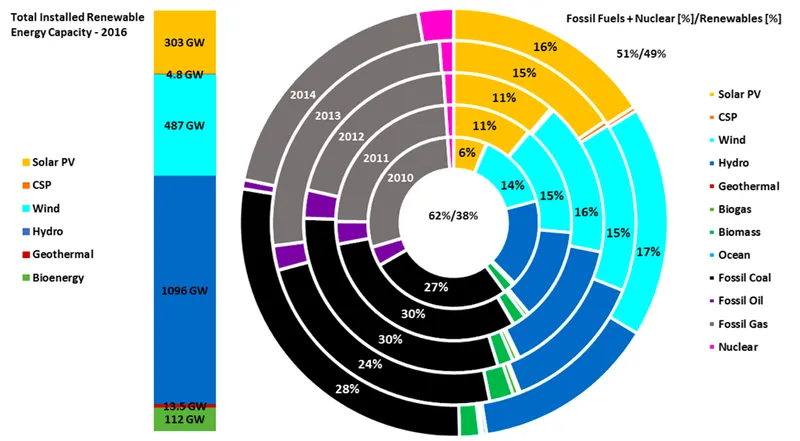A global power sector based entirely on renewables: wishful thinking or an eventual reality?
Renewables-based power generation technologies are set to emerge as the preferred mitigation option to address challenges of climate change.

The devastation wreaked by multiple hurricanes and extreme weather events across the world is clearly in line with scientific predictions that a warming world will not only bring about immense humanitarian crises, but also afflict hefty economic burdens.
This further substantiates the fact that one of the most important challenges confronting the human race is dealing with global climate change. There is an urgent need to curtail as well as phase out global consumption of fossil fuels that still account for a major share of the world’s total energy demand.
According to IPCC’s latest assessment report, the world has already used nearly two-thirds of the available carbon budget, which aims at limiting global mean temperature rise to 2 degrees Celsius. At current and projected rates of consumption, this entire budget will be exhausted by 2040.
As technological progress reshapes the structure of global energy markets in the 21st century, the priorities of producers and consumers around the world are changing rapidly.
In this regard, renewable-based power generation technologies have reached sufficient maturity to not only constitute a sound economic proposition, but also emerge as the preferred mitigation option to address challenges of climate change. Global renewable power capacity, including hydro, has doubled since 2007, from around 1,000 GW to about 2017 GW by the end of 2016, according to the latest report from REN21.
The addition of renewable power capacity in the year 2016, nearly 140 GW, was equivalent to 55 percent of all generating capacity added globally, the highest proportion in any year until now. Renewable power capacity installed annually has been gradually increasing over the last few years, from 38 percent in 2010 to 49 percent in 2014.
The proportion of global electricity coming from renewable sources, including hydropower, has risen from around 25.3 percent in 2015 to 27.7 percent in 2016, and has prevented around 1.7 GtCO2eq of GHG emissions, which substantiates the decoupling of economic growth from fossil fuels.

Nevertheless, phasing out nuclear and fossil fuels entirely from the global energy system is still perceived as a revolutionary idea and many energy experts around the world are sceptical about realising a 100 percent renewables based global energy system.
The International Energy Agency (IEA), one of the most revered and influential stakeholders in the global energy sector, in their flagship report the World Energy Outlook has never shown substantially high projections for renewable energy technologies.
Further, they continuously underestimate the penetration potential of solar photovoltaics (PV) and wind energy, which are globally identified as the key energy generation technologies to mitigate the effects of climate change. Similarly, Shell, with its World Energy Model, and BP, with its Energy Outlook, have been undermining the potential of renewables massively.
On the contrary, there are organisations that have conducted studies to profile the future of the energy sector along a more sustainable pathway to meet the goal of mitigating climate change and realising the potential of renewable energy along with a smarter and more efficient energy system.
Some of these are Bloomberg's New Energy Outlook, GreenPeace's Energy [R]evolution: A Sustainable World Energy Outlook and World Wildlife Fund’s World Energy Report: 100% Renewable Energy by 2050.
While these studies have very novel visions, they do not give a comprehensive perspective in terms of considering vital technical and economic details for the global energy transition.

Decision-makers around the world increasingly require energy transition analyses with high spatial and temporal resolutions, not only on a global scale but also at national and regional levels. In this context, analyses conducted on full hourly resolution can demonstrate in considerable detail the technical viability as well as the economic feasibility of 100 percent renewables based energy systems.
One such recent research conducted by Lappeenranta University of Technology (LUT) and Energy Watch Group (EWG) generated results for a 100 percent renewables based global energy system at hourly resolution for entire years from 2015 until 2050 for the global power sector.
This report presents the results for 145 regions across the world in five-year time periods from 2015 until 2050. The results demonstrate successfully that a 100 percent renewables based power system can contribute significantly to the utmost relevant societal desideratum, which is achieving a net zero emission global power sector by 2050, most importantly, in an affordable manner.
In the subsequent articles, some vital questions with regard to a 100 percent renewable power system will be explored in detail.
Is it technically feasible?
How much will it cost?
Can it sustain global economic growth?
How do we make it happen?
Disclaimer: The views and opinions expressed in this article are those of the author and do not necessarily reflect the views of YourStory.







